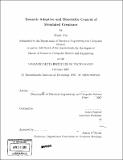Towards adaptive and directable control of simulated creatures
Author(s)
Abe, Yeuhi
DownloadFull printable version (4.386Mb)
Other Contributors
Massachusetts Institute of Technology. Dept. of Electrical Engineering and Computer Science.
Advisor
Jovan Popović.
Terms of use
Metadata
Show full item recordAbstract
Interactive animation is used ubiquitously for entertainment and for the communication of ideas. Active creatures, such as humans, robots, and animals, are often at the heart of such animation and are required to interact in compelling and lifelike ways with their virtual environment. Physical simulation handles such interaction correctly, with a principled approach that adapts easily to different circumstances, changing environments, and unexpected disturbances. However, developing robust control strategies that result in natural motion of active creatures within physical simulation has proved to be a difficult problem. To address this issue, a new and versatile algorithm for the low-level control of animated characters has been developed and tested. It simplifies the process of creating control strategies by automatically accounting for many parameters of the simulation, including the physical properties of the creature and the contact forces between the creature and the virtual environment. This thesis describes two versions of the algorithm (one fast and one feature-rich) and the experiments conducted to evaluate its performance. (cont.) The results include interactive animations of active creatures manipulating objects and balancing in response to significant disturbances from their virtual environment. The algorithm is shown to be directable, adaptive, and fast and to hold promise for a new generation of interactive simulations that feature lifelike creatures acting with the same fluidity and grace exhibited by natural beings.
Description
Thesis (S.M.)--Massachusetts Institute of Technology, Dept. of Electrical Engineering and Computer Science, 2007. Includes bibliographical references (p. 71-77).
Date issued
2007Department
Massachusetts Institute of Technology. Department of Electrical Engineering and Computer SciencePublisher
Massachusetts Institute of Technology
Keywords
Electrical Engineering and Computer Science.